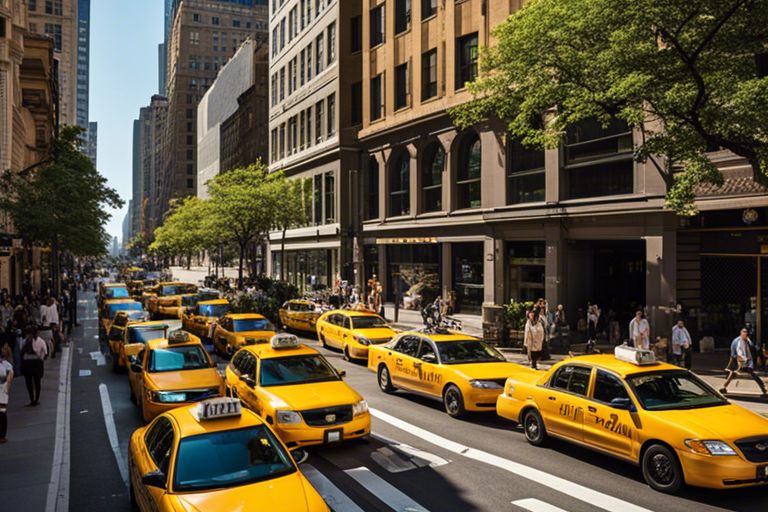Many people often wonder why taxis are universally yellow. This distinctive color choice enhanced visibility in bustling urban environments, making it easier for you to spot a cab from a distance. The bright yellow hue also signifies safety and trust, ensuring you feel secure when you hail a taxi. Not only does this color help drivers locate you quickly, but it also creates a cohesive identity for taxi services. Join us as we research deeper into the fascinating history and reasons behind this iconic color choice.
The History of Yellow Taxis
Early Taxi Innovations
One of the earliest innovations in the taxi industry can be traced back to the introduction of horse-drawn carriages in the late 19th century. As urbanization progressed, these carriages evolved into motorized vehicles, leading to a significant shift in public transportation. The first taxi meter was invented in 1891, facilitating a more reliable passenger pricing method. This advancement made it easier for you to trust that you would pay a fair fare, paving the way for the modern taxi system that we rely on today.
The Adoption of the Yellow Color
An important milestone in the evolution of your taxi experience was the widespread adoption of the yellow color in the early 20th century.
This change was largely attributed to a study conducted by John Hertz, the founder of the Yellow Cab Company, where he discovered that yellow was the most visible color in low-light conditions. Consequently, he painted his fleet of cabs yellow, ensuring they would stand out on the busy streets. As cities expanded and the demand for taxis increased, having a distinct and recognizable color became necessary for drivers and passengers alike. The decision to go yellow made taxis easier to spot and created a brand identity that resonated with customers, becoming a staple of urban life. Today, when you see a yellow taxi, it symbolizes reliability and prompt service, encapsulating decades of history in just one glance.
The Psychology of Color
Assuming you’ve ever wondered why taxis are universally yellow, it’s necessary to explore the psychology of color. Colors profoundly affect human behavior and perceptions, influencing how you react. Yellow, in particular, evokes feelings of happiness, energy, and warmth. It stands out in urban environments, making it easy for you to spot a taxi amidst the hustle and bustle of city life.
Color Recognition
Recognition of colors is crucial in quickly identifying a taxi on the street. Yellow is one of the most visible colors in the human eye, and it easily captures your attention. Research shows that bright colors resonate more effectively in crowded landscapes, so when a yellow taxi drives by, it’s hard for you to miss it.
Impact on Passenger Behavior
Passenger behavior can be heavily influenced by the colors surrounding them. When you see a yellow taxi, it often triggers a sense of urgency or need for action. The vibrant hue can evoke feelings of excitement or adventure, motivating you to wave for a ride.
Plus, the color yellow encourages a quick decision-making process. Knowing it symbolizes availability and service, you’re more likely to feel confident in hailing a yellow taxi. This instant recognition and association promote a sense of comfort and safety, making you feel inclined to utilize taxi services over others that might be less distinguishable. Understanding the psychology behind this color helps you appreciate the strategic choice of yellow as a practical vehicle color.
Branding and Marketing
Even in today’s competitive urban landscape, the color of a taxi isn’t merely a design choice; it’s a crucial branding element. By opting for bright yellow cabs, cities enhance visibility and ensure that taxis are easily spotted amidst the hustle and bustle. This distinctive hue makes taxis more recognizable and reinforces a strong brand identity in the transportation sector, leading to consumer trust and loyalty.
The Importance of Visibility
The importance of visibility cannot be overstated in the taxi industry. Bright colors, especially yellow, are highly conspicuous, making it easier for you and other passengers to locate a cab quickly. This level of visibility increases safety by enhancing the chances of being seen by other vehicles, reducing the risk of accidents, and making hailing a taxi more efficient.
Branding Strategies in the Taxi Industry
An effective branding strategy in the taxi industry includes deploying distinctive colors, unique logos, and well-defined customer experiences. These elements work together to create a memorable impression on passengers. As you recognize a yellow taxi, you’re not just identifying a mode of transport but connecting with all the branding efforts that make that vehicle stand out in a saturated market.
The role of branding in the taxi industry is pivotal. Using distinctive colors like yellow creates an emotional impact and fosters immediate recognition. A uniform design across a fleet presents a cohesive appearance and emphasizes trust and safety. Additionally, taxi companies adopt various marketing strategies, including social media engagement and loyalty programs, to connect with you, enhancing brand loyalty while making your experience more convenient. Ultimately, this blend of visibility and branding solidifies a taxi’s presence in daily urban life.
Conclusion
Taking this into account, the choice of yellow for taxis serves multiple purposes that enhance both safety and visibility. By selecting a bright, eye-catching color, you ensure that your cab is easily identifiable in crowded urban environments, thus promoting efficiency in transportation. This historical decision, rooted in the desire to stand out and be functional, continues to benefit passengers and drivers today. Understanding the reasoning behind the yellow taxi can deepen your appreciation for these everyday vehicles that play a crucial role in city life.
Book Luxury Rides Today



